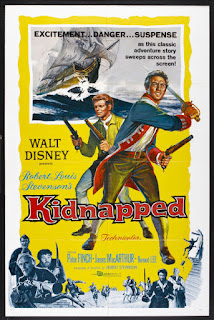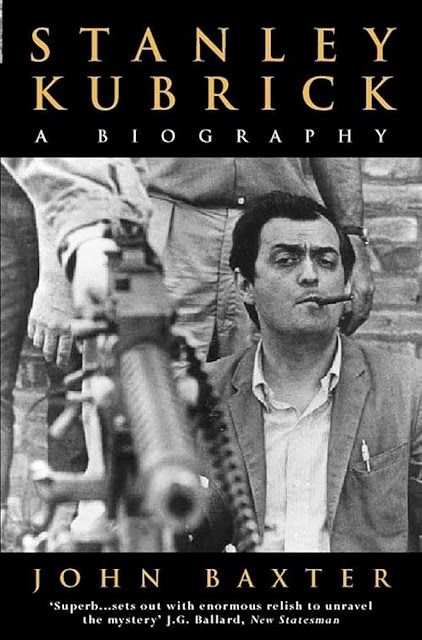Kidnapped (1960)
Partly due to rising costs on its animated films, Walt Disney branched out into making live action features in the 1950s, beginning with Treasure Island in 1950.
Production company Walt Disney Productions Distributor Buena Vista, Walt Disney
In common with several other American companies, Disney had blocked funds in the UK that couldn't be repatriated to the US, and making films in Britain was a useful way of using this money. For this reason, several of the 1950s Disney films have a decidedly British accent, including The Story of Robin Hood and His Merrie Men, Rob Roy the Highland Rogue, Greyfriars Bobby and Kidnapped.
Like Treasure Island, Kidnapped is based on a novel by Robert Louis Stevenson. The story is set in the years following the Jacobite rebellion of 1745. After the death of his father, young David Balfour (James MacArthur) arrives with a letter of introduction to his supposedly well-to-do uncle (John Laurie).
Like Treasure Island, Kidnapped is based on a novel by Robert Louis Stevenson. The story is set in the years following the Jacobite rebellion of 1745. After the death of his father, young David Balfour (James MacArthur) arrives with a letter of introduction to his supposedly well-to-do uncle (John Laurie).
But the uncle's claim to the ancestral home is a bit shaky, so he would rather be rid of David who, unbeknown to him, has the better claim. So he tricks him onto the ship of Captain Hoseason (Bernard Lee) where he is to be transported to the Carolinas and into indentured servitude.
His salvation comes when their ship unexpectedly picks up a passenger, Alan Breck Stewart (Peter Finch), a Jacobite heading to France. Together they must escape from the ship, avoid the redcoats and claim David's rightful inheritance.
Kidnapped is a mild, episodic adventure which is a relatively faithful adaptation of Stevenson's 1886 novel. The screenplay was by the film's director Robert Stevenson, who Disney's publicity material at the time incorrectly claimed was a distant relative of the author.
Kidnapped is a mild, episodic adventure which is a relatively faithful adaptation of Stevenson's 1886 novel. The screenplay was by the film's director Robert Stevenson, who Disney's publicity material at the time incorrectly claimed was a distant relative of the author.
The story incorporates real historical events, notably the unsolved murder of Colin Campbell near Appin in 1752. Alan “Breck” Stewart was a real person, a soldier in the British army who deserted to join the Jacobite cause. He was a prime suspect in the murder of Campbell and was turned into a heroic outlaw figure by Robert Louis Stevenson and others.
The film doesn't really explain the historical background, and prefers to concentrate on a simple adventure story with a developing surrogate father-son relationship between Stewart and Balfour.
The film doesn't really explain the historical background, and prefers to concentrate on a simple adventure story with a developing surrogate father-son relationship between Stewart and Balfour.
Balfour is a lowlander and supporter of the King, while Stewart is a highlander and supporter of the Jacobites, and the film does a good job in differentiating between highlanders and lowlanders. But the complicated politics and differing loyalties probably confused American audiences in 1960 and wouldn't be any better understood now, with most viewers unsure about who is against who and why, and bemused by the panoply of Whigs, Jacobites, Stuarts and Campbells.
With a couple of exceptions, the live action Disney films of this era are not especially well remembered now, and a younger audience today would probably also find this lacking in excitement. But then the action highlights do include the two heroes hiding under some leaves and, later on, walking slowly across a bridge!
With a couple of exceptions, the live action Disney films of this era are not especially well remembered now, and a younger audience today would probably also find this lacking in excitement. But then the action highlights do include the two heroes hiding under some leaves and, later on, walking slowly across a bridge!
The film is mostly studio-bound in its first half, with interior sets standing in for exteriors and models used for its ships. This studio material was filmed at Pinewood Studios in England. In the film's second half there is more use of real locations.
The casting is a little hit and miss. Finch is fine as the rugged outlaw highlander Alan Breck Stewart and James MacArthur is adequate in the less interesting role of David Balfour. MacArthur was cast because he was under contract to Disney, but Scottish accents are something that American actors should never be asked to attempt.
The casting is a little hit and miss. Finch is fine as the rugged outlaw highlander Alan Breck Stewart and James MacArthur is adequate in the less interesting role of David Balfour. MacArthur was cast because he was under contract to Disney, but Scottish accents are something that American actors should never be asked to attempt.
John Laurie, however, is perfect in a classic John Laurie role, as a suspicious and miserly Scotsman. The ship's captain is played by Bernard Lee in an atypical part, complete with beard, bushy eyebrows and vaguely Scottish accent. Later in the film we get Finlay Currie as a clan chief, Miles Malleson as a lawyer and, unexpectedly, Peter O'Toole in one of his first film roles, in a curious scene where he and Finch engage in a pipe-off to see which is the best bagpiper.
Several of the actors were regulars in adaptations of this story. John Laurie had played the same role of Ebenezer in the 1956 BBC series of Kidnapped, and Duncan Macrae, who plays the highlander on the beach, also played the Ebenezer role in a 1963 TV series. Eileen Way, as one of the film's only female characters, also appeared in the 1963 version. The director of photography, Paul Beeson, who worked on several other Disney features, was the cinematographer on this film and the 1971 version of Kidnapped, starring Michael Caine.
The story of Kidnapped has been told many times in film and TV over the years, and not always all that well. The 1960 film is one of the better versions and is surprisingly un-Disneyfied. While not a great film, it's a serviceable and relatively faithful adaptation of the novel and is one of the better Disney live-action films of its time.
Kidnapped
Several of the actors were regulars in adaptations of this story. John Laurie had played the same role of Ebenezer in the 1956 BBC series of Kidnapped, and Duncan Macrae, who plays the highlander on the beach, also played the Ebenezer role in a 1963 TV series. Eileen Way, as one of the film's only female characters, also appeared in the 1963 version. The director of photography, Paul Beeson, who worked on several other Disney features, was the cinematographer on this film and the 1971 version of Kidnapped, starring Michael Caine.
The story of Kidnapped has been told many times in film and TV over the years, and not always all that well. The 1960 film is one of the better versions and is surprisingly un-Disneyfied. While not a great film, it's a serviceable and relatively faithful adaptation of the novel and is one of the better Disney live-action films of its time.
Year: 1960
Genre: Historical Adventure
Country: UK / USA
Director: Robert Stevenson
Cast Peter Finch (Alan Breck Stewart), James MacArthur (David Balfour), Bernard Lee (Captain Hoseason), John Laurie (Ebenezer Balfour), Niall MacGinnis (Shuan), Finlay Currie (Cluny MacPherson), Miles Malleson (Mr. Rankeillor), Duncan Macrae (The Highlander), Andrew Cruickshank (Colin Campbell), Peter O'Toole (Robin MacGregor), Alex Mackenzie (The Ferryman), Oliver Johnston (Mr. Campbell), Norman MacOwan (Tinker), Eileen Way (Jennet Clouston), Edie Martin (Woman on the bridge), Abe Barker (Donald Dhu MacLaren), John Pike (Cabin Boy)
Screenplay Robert Stevenson based on the novel by Robert Louis Stevenson Cinematography Paul Beeson Art director Carmen Dillon Editor Gordon Stone Music Cedric Thorpe Davie Costumes Margaret Furse
Running time 97 mins Colour Technicolor
Genre: Historical Adventure
Country: UK / USA
Director: Robert Stevenson
Cast Peter Finch (Alan Breck Stewart), James MacArthur (David Balfour), Bernard Lee (Captain Hoseason), John Laurie (Ebenezer Balfour), Niall MacGinnis (Shuan), Finlay Currie (Cluny MacPherson), Miles Malleson (Mr. Rankeillor), Duncan Macrae (The Highlander), Andrew Cruickshank (Colin Campbell), Peter O'Toole (Robin MacGregor), Alex Mackenzie (The Ferryman), Oliver Johnston (Mr. Campbell), Norman MacOwan (Tinker), Eileen Way (Jennet Clouston), Edie Martin (Woman on the bridge), Abe Barker (Donald Dhu MacLaren), John Pike (Cabin Boy)
Screenplay Robert Stevenson based on the novel by Robert Louis Stevenson Cinematography Paul Beeson Art director Carmen Dillon Editor Gordon Stone Music Cedric Thorpe Davie Costumes Margaret Furse
Running time 97 mins Colour Technicolor
Production company Walt Disney Productions Distributor Buena Vista, Walt Disney




Comments
Post a Comment